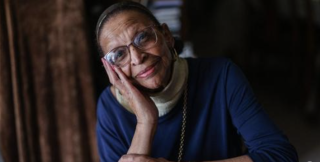Lillie Crowder is a living archive — a witness and participant in the Civil Rights Movement and an educating force for those who choose to listen.
Her ranch-style home in Middle Island, where accolades and awards for activism line the walls, serves as evidence.
The certificates and other shows of appreciation are a testament to Crowder's life, from her civil rights-era activism in her native South Carolina to her efforts to increase racial and gender representation in politics on Long Island, to helping to design and modernize New York City schools.
“From Jim Crow to now ... it's been quite a trek," she said.
WHAT TO KNOW
Lillie Crowder, 86, one of the few Black women in the mostly white architecture field, overcame denials and slights to help design and modernize New York City schools.
In her South Carolina hometown, Crowder, of Middle Island, saw racial segregation up close and was inspired to pursue a career in the architecture field.
She continues to find ways to tell her story to future generations, including in April at Stony Brook University.
At 86, during Women's History Month, Crowder looked back on her life in an interview with Newsday, speaking about her work mentoring others and continuing to pass on what she has learned.
Mentoring in Suffolk County
Crowder withstood the denials and slights of being a woman and Black in a largely white architecture field to go on to help design several New York City schools. And, in her retirement, she founded the Brookhaven Rosa Parks Democratic Association, through which she mentored leaders like Suffolk County Sheriff Errol D. Toulon Jr.
“Through her tutelage, it really helped me … really understand that I can have a voice that can make a difference,” said Toulon, the first Black sheriff in Suffolk County history.
For Crowder, the roots of her activism and career start in Georgetown, South Carolina — a place where she could peer into the sky and be transfixed by the design of the town clock or a church steeple. It also was where she lived under Jim Crow laws and had to walk on the opposite side of the street from white residents “to stay safe,” she said.
But in the 1950s, ideas of how to challenge those segregation laws emerged within at South Carolina State University. The Supreme Court's 1954 Brown v. Board of Education decision struck down racial segregation in public schools and helped galvanize students at the historically Black college in Orangeburg.
“I would think that was the one document [or] mandate that awakened me and others of my age that there was something wrong with the system — and that there could be some improvement,” she said of the landmark court decision.
Campus protests in South Carolina
Seeking the promise of change, Crowder and other students took part in protests against unequal treatment, she said. They also boycotted the school cafeteria, which sourced food from restaurants the NAACP had boycotted.
In 1968, years after Crowder graduated from the university, the South Carolina Highway Patrol opened fire on student protesters, killing three and leaving nearly 30 injured, the university said.
Joseph C. Sanders, who attended the university around that time but met Crowder in the 1980s, said she once told him of her struggles with a professor who didn't believe a woman should be in the architecture field, forcing her to work harder into the evenings after many other students were asleep.
“She had to sit in the [dorm] stairway because the light was on all night and do all of her studying,” said Sanders, who lives in Orangeburg.
Bringing people together
Decades later, records show, that determination was displayed again when she held meetings in a church on Long Island in 2006 as she sought to start the Brookhaven Rosa Parks Democratic Association. Crowder cofounded the organization, which focuses on fostering political activity and equal government access.
Beverly Dean, the current president of the association, said it was extremely difficult for the Town of Brookhaven to elect a Black or brown person at the time because there was no organization to bring people together.
“She was able to get people elected, not necessarily always African American people, but people who had ideas of how to bring people together to bring equal rights to everyone,” said Dean, who has a doctorate in nursing practice.
Around 2012, Toulon met Crowder through the association, looking for more ways to be involved in the community. Toulon, who was sworn in as sheriff in 2018, said he was inspired to see Crowder teach residents about government and empower themselves to improve their lives.
He distinctly remembered her often paraphrasing a saying from Shirley Chisholm, the first Black woman elected to Congress: “If they don't give you a seat at the table, bring a folding chair.”
Back in 1958, Crowder was armed with a college degree but faced scant career opportunities. One architecture job fell through in Washington, D.C., and she worked at a restaurant until a South Carolina principal told her mother that she should teach mechanical drawing at a segregated high school in her hometown, she said.
Yet, her longing for a career squarely in her field of study did not abate. In 1960, she boarded a bus and arrived in New York City with an eye on her future and at last, a chance to realize her career goals.
Failure not an option
At the time, she remembers telling herself: “I absolutely will not fail.”
“Because if I failed, I would have failed my parents,” she recalled.
In New York City, she would find opportunities not afforded to her in the South, but only after years of facing denials. Crowder eventually found work as a junior engineer and chief draftsman.
She later started working at the New York City Board of Education, part of a team helping to modernize and design schools.
One of the schools built during that time was Intermediate School 201 in East Harlem. Designed by New Orleans-based architects, it was windowless and faced pushback from angry parents, according to the book “Educating Harlem: A Century of Schooling and Resistance in a Black Community.”
Crowder said in an interview with Newsday that she was tasked with helping deal with ventilation issues.
When later asked about the building, Crowder described it as having an “interesting concept” but criticized the architects for having “little thought at the time of the potential psychological effects on children inside,” the book said.
'There's a place for you'
In 1998, Crowder retired from the city board of education after roughly 30 years and later moved to Brookhaven Town with her husband, Clarence Irving Sr., who played an important role in the development of the Black Heritage stamp series.
Collette Morgan, former president of the National Coalition of 100 Black Women Suffolk County Chapter, said she remembers knocking on doors with Crowder to get enough signatures to put Democratic Party committee members and candidates on the ballot.
“She was always the one to say, 'Well, let's do these 10 more houses right here' when everyone else was tired,” Morgan said.
Crowder maintains that same energy today. A mostly self-taught pianist, she has written a number of compositions. She is also a poet.
But she is still keenly focused on continuing to help the next generation.
Crowder's message for young people who want to pursue a career in architecture or beyond is: “There's a place for you.”

